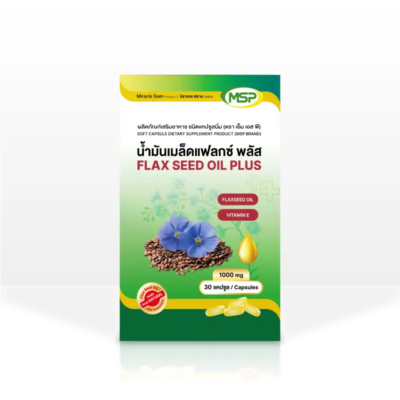Health Benefits of Flaxseed
Flaxseed also called linseed (Linum usitatissimum) belongs to the genus Linum in the family Linaceae. Flaxseed typically yields 35 – 45% oil, containing 9 – 10% of saturated fatty acids (palmitic and stearic), about 20% monounsaturated fatty acids (mainly oleic acid), and more than 70% α-linolenic acid. The protein level of flaxseed ranges from 20 to 30%, while its dietary fiber content may reach up to 28%. The components of flaxseed oil vary depending on the seed cultivar, location, environmental condition, and methods of analysis [1].
Due to its unique chemical composition, flaxseed oil is widely known for its health advantages. It is one of the best plant-based sources of polyunsaturated omega-3 fatty acids. The primary components of flaxseed oil are fatty acids, specifically linoleic (LA) and α-linolenic (ALA) fatty acids. Linoleic acid is converted to arachidonic acid, whereas α-linolenic acid is converted to eicosapentaenoic acid (EPA). Arachidonic acid is the progenitor of PGH2 that is further converted to prostaglandin E2 (PGE2) and thromboxane A2 (TXA2) via a cyclooxygenase.
Arachidonic acid also serves as a precursor of leukotriene A4 (LTA4), which is converted into leukotriene B4 (LTB4) by 5-lipoxygenase. EPA is an n-3 homologue that can inhibit arachidonic acid metabolism via competitive inhibition. Leukotriene B5 (LTB5), which has less inflammatory action than LTB4, is formed when 5-lipoxygenase uses EPA as a substrate. The ALA is widely used as an anti-inflammatory agent by decreasing the production of inflammatory cytokines, lipids, and lipoprotein [1].

Metabolic effects
A study investigated the effect of flaxseed oil on high-cholesterol diet-induced blood lipids, atherosclerosis, serum malondialdehyde, aortic chemiluminescence, and reactive oxygen species (ROS) in rabbits. The serum levels of serum total cholesterol (TC), low-density lipoprotein cholesterol (LDL-C), high-density lipoprotein cholesterol (HDL-C), triglycerides (TG), antioxidant markers, and malondialdehyde were found to be elevated in both groups, which included the 0.5% cholesterol diet group and the group that consumed a diet containing 5% flaxseed oil and 0.5% cholesterol.
These increases were observed when comparing the results to the groups that consumed 0.5% flaxseed and the control group. The 0.5% cholesterol diet group had higher levels of ROS-producing white blood cell activity and flaxseed oil prevented such increase induced by cholesterol [1].
In white rats fed a high-fat diet, the plasma levels of TG and TC were considerably lowered after 60 days of treatment with flaxseed oil (1 g/kg body weight). On the other hand, in rats fed a regular diet, flaxseed oil had no influence on TC and TG levels. According to Nounou et al., myocardial ischemia in rats results in elevated serum levels of TC and TG, decreased serum levels of LDL-C and no change in HDL-C. In their study, they demonstrated flaxseed oil (0.4 g/kg daily for 6 weeks) reduced the serum levels of TG, TC, and LDL-C, but had no effect on HDL-C in rats with myocardial ischemia [2].
Metabolic effects 2
Kaul et al reported that oral administration of flax oil (1 g/d for 3 months) to healthy patients did not significantly alter serum levels of TC, HDL-C, LDL-C, and TG. In healthy adults, a flax oil diet containing 28.8% of its energy from fat did not significantly change serum levels of TG, TC, HDL-C, LDL-C, Apo-A1, and Apo-B. According to Singer et al., 14 patients with mild essential hypertension who received 60 mL/d of flaxseed oil for two weeks showed a significant drop in their serum levels of TC, LDL-C, TG, and LDL-C/HDL-C ratios.
In another study, the effects of daily 12-week consumption of 10-g flax oil (containing 5.49-g ALA) and 10-g corn oil (containing 0.09-g ALA) in 15 patients were observed.
Flax oil significantly reduced CETP levels and to a greater degree than corn oil. Additionally, flax oil significantly reduced the serum levels of TC, LDL-C, HDL-C, and non-HDL-C, as well as Apo-A1 and Apo-B, when compared to corn oil. The levels of TG were not affected with either flax oil or corn oil.
The data suggest that flax oil certainly reduces the levels of TC, LDL-C, HDL-C, non-HDL-C, Apo-A, and Apo-B. The data indicates that there is considerable variation in the impact of flaxseed oil on the serum lipid levels of people with normocholesterolemia and hypercholesterolemia. High doses (>25-g ALA) seem to lower serum levels of TG, Apo-A1, Apo-B, LDL-C, HDL-C, and TC [2].

Anti-Inflammatory Properties of Flaxseed
Anti-inflammatory agents are widely derived from natural sources. The inflammatory response is a self-limiting process that is controlled by negative feedback systems so as to avoid too damaging the host. The pathology of inflammation can be explained by an increased blood supply to the site of inflammation, increased capillary permeability, leukocyte migration from the capillaries into the surrounding tissue, releasing some inflammatory mediators from leukocytes at the inflammation site and these inflammatory mediators are lipid mediators (e.g., n-6 eicosanoids, PGE2, and LTB4).
Depending on the kind of cell involved, there are additional significant peptide mediators such as cytokines, interleukin 1β (IL-1β), and tumor necrosis factor-α (TNF-α), as well as ROS, amino acid derivatives (histamine), and enzymes (matrix protease).
EPA serves as a substrate for cyclooxygenase in the biosynthesis of PGE3, which likewise has an inflammatory effect, despite the low efficiency of PGE3 biosynthesis. Leukotrienes, which have five double bonds, and prostaglandins, which have three double bonds, are also produced as a precursor to EPA.
These altered products are thought to mediate the anti-inflammatory effects of ALA and DHA. Through mechanisms involving lipoxygenases and cyclooxygenases, they can also create resolvins and other similar molecules (e.g., protectins). These mediators act synergistically as anti-inflammatory, i.e., resolvin E1, resolvin D1, and protectin D1 to all inhibit transendothelial migration of neutrophils preventing their infiltration at sites of inflammation.
Further, resolvin D1 inhibits IL-1β production, whereas protectin D1 inhibits TNF and IL-1β production [1].
Effects on bone health
Modern diets tend to be richer in saturated fats as a result of economic progress. Diet is one of the risk factors for osteoporosis in addition to heredity, age, estrogen deficiency, and calcium and phosphorus metabolism. A high-fat diet has been shown in multiple studies to have a negative impact on bone health.
High body fat percentage was found to be a risk factor for osteoporosis as people aged in a population research included people in their middle to later years. EPA, DHA, and ALA are omega-3 unsaturated fatty acids that can resist arteriosclerosis, reduce inflammatory factors, and lessen lipid disorders [3].
Osteogenesis generally involves three major phases: proliferation, extracellular matrix formation and mineralization, which are regulated by a diverse set of key factors, such as transcription factors, growth factors, hormones and signaling pathways.
Runt-related transcription factor 2 (RUNX2) was identified as a particular regulator in osteoblastic differentiation at the whole stage, thus activating the expression of osteogenic-related genes. Moreover, research has shown that RUNX2 acts as a transcriptional activator or repressor and behaves more as a promoter than a transcription factor.
Another transcription factor involved in osteoblastic differentiation and bone formation is osterix. Following mesenchymal condensation driven by RUNX2, osterix plays a crucial role in osteoblastic differentiation. Chen F et al. showed that ALA promoted the expression of the osteogenic transcription factors RUNX2 and osterix. In a concentration-dependent manner, ALA counteracted the inhibitory action of PA, which suppressed the expression of RUNX2 and osterix [3].
Another study revealed that one of the necessary omega-3 fatty acids, ALA, found in flaxseed, reduces the content and synthesis of PGE2 in the bone. PGE2 is an eicosanoid primer that promotes osteoclast genesis. Additionally, ALA can prevent osteoclast formation and activity by lowering the levels of pre-inflammatory cytokines such TNF-α, IL-1β, and interleukin-6 (IL-6).
Furthermore, some in vitro and animal studies have demonstrated that omega-3 fatty acids inhibit osteoclastogenesis by either upregulating the expression of osteoprotegerin, which functions as a decoy receptor for RANKL, or decreasing the expression of receptor activator of nuclear factor kappa B ligand (RANKL) [4].
Flaxseed and the Skin
Skin physiology is greatly influenced by omega-3 fatty acids, and studies have demonstrated that supplementing with flaxseed oil can significantly enhance skin health. Participants in the Neukam et al. study were split into two groups. The first group received four capsules of flaxseed oil (555.32 mg/capsule) and the second group received four capsules of safflower oil (560 mg/capsule) for 12 weeks.
Transepidermal water loss, skin hydration, skin sensitivity, and plasma polyunsaturated fatty acids were assessed at baseline as well as at weeks six and twelve.
Supplementation with flaxseed oil led to significant decreases in sensitivity, skin roughness, scaling, and transepidermal water loss, while epidermal hydration and smoothness were increased compared to the group being supplemented with safflower oil [5].
Anticancer activity
Flaxseed, one of the richest plant sources of lignans, has the potential to inhibit tumor growth, the progression of diseases, and angiogenesis, as well as to reverse early malignant lesions. It has been shown that flaxseed lignans can disrupt the malignant tumor’s phenotype, influencing its cellular properties. In addition, flaxseed lignans, by affecting connections in molecular signaling networks, modulate signaling cascades in various stages of cancer.
Therefore, flaxseed lignans can inhibit the progression of various types of cancers [5].
The direct effects of flaxseed oil on the growth of cancer cells in vitro were also used to illustrate the oil’s anticancer properties. While non-malignant cell lines showed only slight increases in cell growth, a variety of cancer cell lines treated with flaxseed oil had a dose-dependent reduction in cell growth. B16-BL6 cells were treated with 0.3% or 0.9% flaxseed oil for 4 days.
B16-BL6 cell growth was completely inhibited by 0.9% flaxseed oil treatment, while 0.3% flaxseed oil therapy reduced the number of cells by around 50%. The authors of the study observed that cancer cells treated with a 10−5 or 10−6 M mixture of fatty acids, including ALA, DHA, EPA, and the lignans (ENL and END) reduced cell growth [5].
References
- Al-Madhagy S, Ashmawy N, Mamdouh A, Eldahshan O, Farag M. A comprehensive review of the health benefits of flaxseed oil in relation to its chemical composition and comparison with other omega-3-rich oils. European Journal of Medical Research. 2023 [cited 2024 March 11]; 28: 1-17. Available form: https://eurjmedres.biomedcentral.com/articles/10.1186/s40001-023-01203-6
- Prasad K, Khan A, Shoker M. Flaxseed and Its Components in Treatment of Hyperlipidemia and Cardiovascular Disease. International Journal of Angiology. 2020 [cited 2024 March 11]; 29: 216-22. Available form: https://www.thieme-connect.com/products/ejournals/html/10.1055/s-0040-1709129
- Chen F, Wang Y, Wang H, Dong Z, Wang Y, Zhang M, et al. Flaxseed oil ameliorated high-fat-diet-induced bone loss in rats by promoting osteoblastic function in rat primary osteoblasts. Nutrition & Metabolism. 2019 [cited 2024 March 11]; 16: 1-13. Available form: https://nutritionandmetabolism.biomedcentral.com/articles/10.1186/s12986-019-0393-0
- Kheiridoost-Langaroodi H, Shakouri S, Amirpour M, Iranshahi A, Farshbaf-Khalili A. The Effect of Selected Herbal Medicines on Bone Turnover Markers: A Systematic Review and Meta-Analysis. Journal of Family and Reproductive Health. 2022 [cited 2024 March 11]; 16: 16-32. Available form: https://www.ncbi.nlm.nih.gov/pmc/articles/PMC9287118/
- Nowak W, Jeziorek M. The Role of Flaxseed in Improving Human Health. Healthcare (Basel). 2023 [cited 2024 March 11]; 11: 1-20. Available form: https://www.mdpi.com/2227-9032/11/3/395
- FLAX SEED OIL PLUS | MIRACLE SIAM PRODUCT https://msp-th.com/en/products/flax-seed-oil-plus

